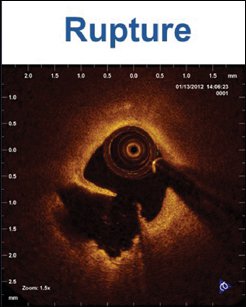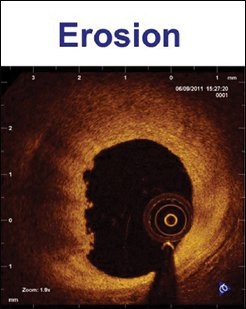OCT Sheds New Light on ACS
Acute coronary syndromes result in more than 1 million hospital admissions per year in the United States and remain the leading cause of sudden cardiac death.
For many years, intracoronary plaque rupture was considered the primary underlying mechanism of ACS and was the only mechanism amenable to in vivo imaging. Pathological studies had shown that 60% of ACS cases with coronary thrombosis were caused by plaque rupture and 40% were due to plaque erosion (with an absence of rupture into a lipid core of the culprit lesion).
Recently, an emerging intracoronary imaging modality — optical coherence tomography — has provided a better understanding of the varied mechanisms underlying ACS. The ability of OCT to quickly image the culprit lesion in ACS and diagnose its underlying mechanism in real-time may lead to our ability to individualize therapy for patients with ACS in the future.
A New Technique
OCT is an exciting catheter-based intravascular imaging technique that utilizes back reflection of near-infrared light to generate rapid, safe, high-resolution intracoronary imaging.
OCT is analogous to IVUS, which is well known and widely utilized for coronary imaging, but uses light energy instead of sound. OCT has far superior spatial resolution (10 µ to 20 µ) compared with IVUS (150 µ to 250 µ), and allows visualization of the microstructure of atherosclerotic plaque (fibrous cap, lipid, thrombus and calcification). Coronary imaging by OCT has been safely incorporated into cardiac catheterization procedures with low complication rates, and can be performed rapidly and easily during most procedures.
![Figure 1. Relative incidence of the three main mechanisms of ACS (plaque rupture, plaque erosion [OCT-erosion] and protruding calcified nodule [OCT-CN]) as characterized by OCT in patients of the Massachusetts General Hospital OCT Registry.](/~/media/news/print/cardiology-today-intervention/2015/07_july/oct-sheds-new-light-on-acs/relative_incidence_three_mechanisms_acs_chart.jpg)
Figure 1. Relative incidence of the three main mechanisms of ACS (plaque rupture, plaque erosion [OCT-erosion] and protruding calcified nodule [OCT-CN]) as characterized by OCT in patients of the Massachusetts General Hospital OCT Registry.
Figures reprinted from Journal of the American College of Cardiology, volume 61/issue 19, Jia H, et al, In Vivo Diagnosis of Plaque Erosion and Calcified Nodule in Patients with Acute Coronary Syndromes by Intravascular Optical Coherence Tomography, Pages 1748-1758, Copyright (2013), with permission from Elsevier.
To date, OCT studies in ACS have revealed that thin-cap fibroatheroma, defined as lesions with large lipid pools with overlying thin fibrous cap (< 65 µ), constitute vulnerable plaque likely to rupture and cause ACS. We have discovered that decreased fibrous cap thickness is an important discriminator between those thin-cap fibroatheroma that rupture compared with unruptured thin-cap fibroatheroma, and that plaque burden and luminal stenosis in this setting combine to produce ACS. Furthermore, although three times more thin-cap fibroatheroma are seen in nonsevere coronary stenoses, it is twice as likely for a lesion to be a thin-cap fibroatheroma in lesions causing severe stenosis. These thin-cap fibroatheroma in severely stenotic lesions had more morphological features of plaque vulnerability than those in nonsevere stenoses. This observation was particularly interesting given the long-standing previous teaching, based on autopsy studies, that most ACS are the result of plaque rupture in mildly stenotic coronary lesions.



Figure 2. OCT characteristics of the three main mechanisms of ACS. TOP: Plaque rupture characterized by disrupted thin fibrous cap and cavity formation within the underlying lipid plaque. CENTER: Plaque erosion characterized by relatively preserved vascular integrity and luminal area without cap disruption and overlying residual red thrombus. BOTTOM: Protruding calcified nodule characterized by a nodular calcification protruding into the lumen through a disrupted fibrous cap.
Use in ACS
Recently, OCT has allowed the in vivo characterization of culprit lesions in ACS and, for the first time, established the prevalence of pathophysiologic mechanisms, other than traditional plaque rupture, in patients with ACS. The three main mechanisms of sudden cardiac death, STEMI and non-ST-elevation ACS (non-STEACS) described in pathological studies have been well characterized as plaque rupture, plaque erosion and protruding calcified nodule.
In a recent study of patients with ACS in the Massachusetts General Hospital OCT Registry, a multicenter, international registry of patients undergoing OCT coronary imaging at the time of invasive coronary angiography, OCT definitions of these three ACS mechanisms were established. The analysis revealed that only 53% of ACS culprit lesions were due to plaque rupture, whereas 38% were due to plaque erosion and 9% were due to protruding calcified nodules.
Although several more rare mechanisms of ACS exist, such as tight stenosis, spasm, dissection, hematoma and fissure, these were excluded from this analysis (Figure 1). Plaque erosion has distinct anatomic features, consisting of relatively preserved vascular integrity without a disrupted fibrous cap or superficial lipid. Plaque erosion lesions also demonstrate relatively large luminal area and significant overlying platelet-rich thrombus. These features are all readily recognized by OCT, and contrast with the typical OCT features of plaque rupture, such as disrupted fibrous cap with underlying lipid-laden plaque (Figure 2, p. 10). Plaque erosion was found in this analysis to be most common in non-STEACS and in younger patients, whereas plaque rupture was more common in older patients and in STEMI.
Treatment Effect of Imaging
The ability of OCT to better characterize ACS culprit lesions in real time has been enlightening, but the question remains whether it leads to advances in the treatment of patients with ACS.
Indeed, it has been reported that ACS due to plaque erosion can respond favorably to aggressive antithrombotic therapy without stenting. This is thought possible because of the relatively preserved vascular integrity seen in plaque erosion and the lack of critical luminal stenosis that is typical of these cases. Therefore, it is conceivable to treat patients with ACS caused by plaque erosion primarily with antithrombotic medications, such as aspirin, P2Y12 inhibitors, heparin and glycoprotein IIb/IIIa inhibitors, rather than stenting, thereby avoiding potential stent-related complications including early and late stent thrombosis or restenosis. Such therapy for ACS based on real-time in vivo imaging analysis of the culprit lesion is attractive in an era when personalized medicine and tailored therapies are coming to the forefront in all areas of medicine. Whether the traditional paradigm of stenting all culprit lesions in ACS will last, or an individualized treatment approach based on OCT imaging will be superior, is yet to be determined and will require future prospective clinical investigations.
Future Implications
OCT is a promising new intracoronary imaging modality that has been safely and effectively integrated into coronary procedures in the modern cardiac catheterization laboratory. The high-resolution imaging afforded by OCT has provided valuable insights into the plaque characteristics underlying vulnerable plaques and ACS pathophysiology. Recently, OCT was proved capable of differentiating plaque rupture from plaque erosion, a common mechanism of ACS.
This has potential implications for new therapeutic pathways in ACS and progress toward personalized medicine for these patients.
- References:
- Hu SK, et al. JACC Cardiovasc Interv. 2014;doi:10.1016/j.jcin.2013.10.024.
- Jia H, et al. J Am Coll Cardiol. 2013;doi:10.1016/j.jacc.2013.05.071.
- Tian J, et al. J Am Coll Cardiol. 2014;doi:10.1016/j.jacc.2014.01.061.
- Tian J, et al. J Am Coll Cardiol. 2014;doi:10.1016/j.jacc.2014.05.052.
- van der Wal AC, et al. Circulation. 1994;89:36-44.
- For more information:
- Robert Gallagher, MD, is an interventional cardiologist at Massachusetts General Hospital.
- Ik-Kyung Jang, MD, PhD, is director of the Clinical Trials Program at Massachusetts General Hospital Corrigan Minehan Heart Center. The authors can be reached at Interventional Cardiology Associates, 55 Fruit St., Boston, MA 02114.
Disclosures: Gallagher reports no relevant financial disclosures. Jang reports receiving grant/consultant fees from St. Jude Medical.
